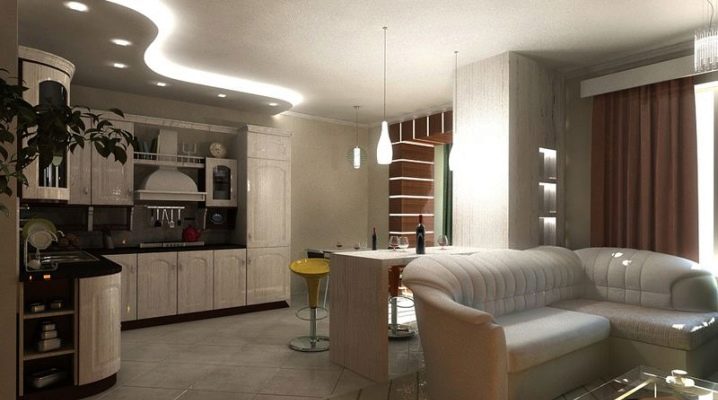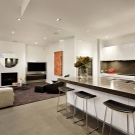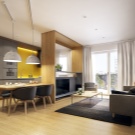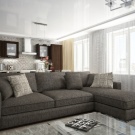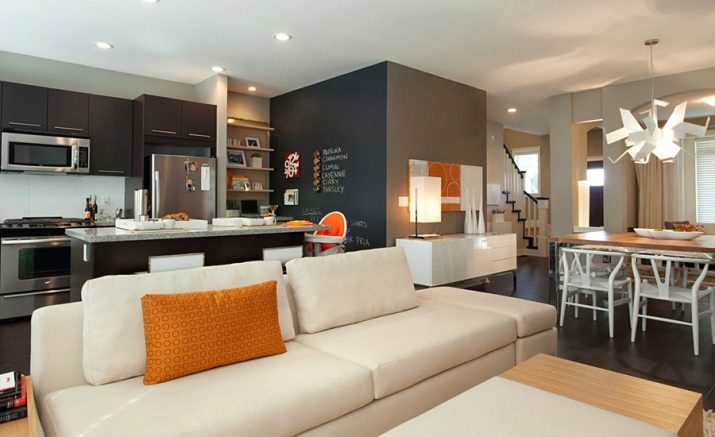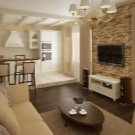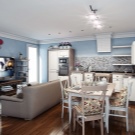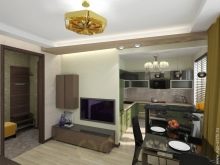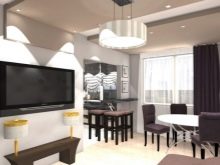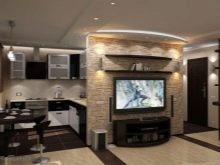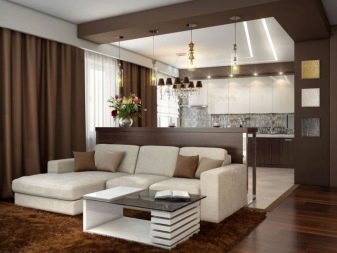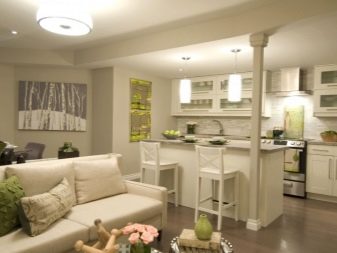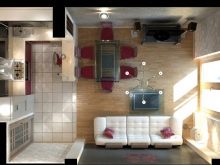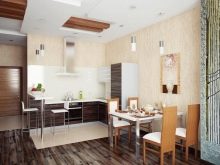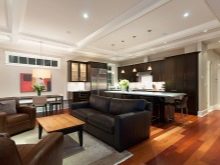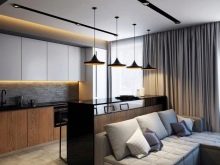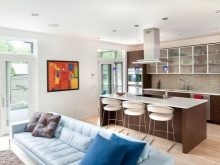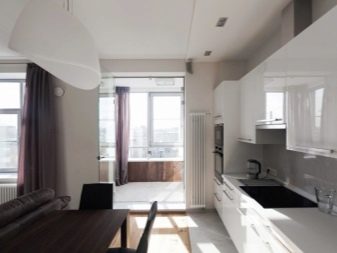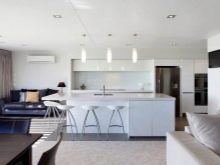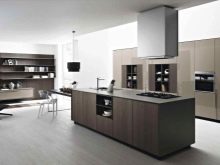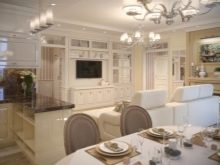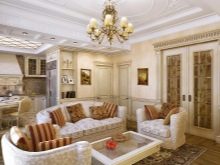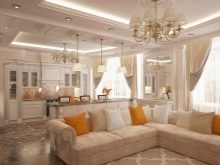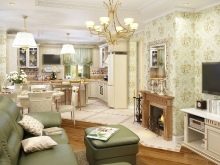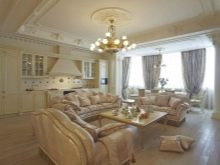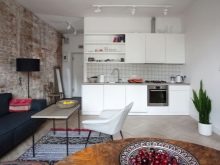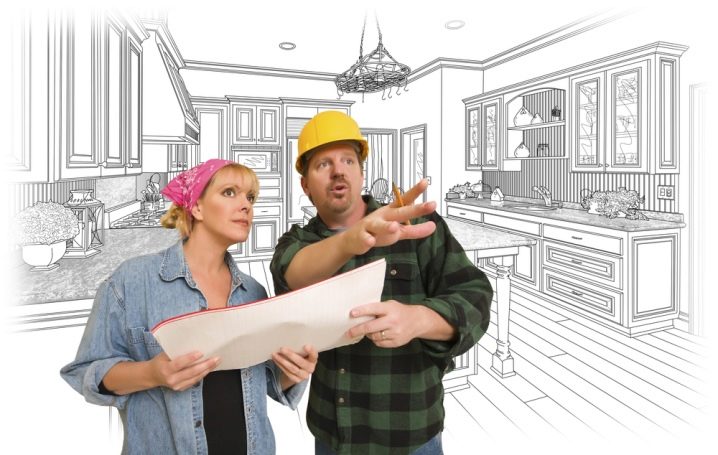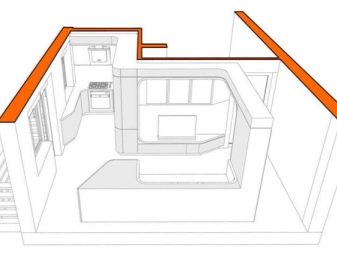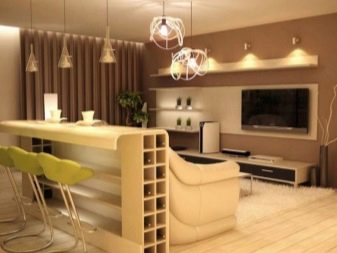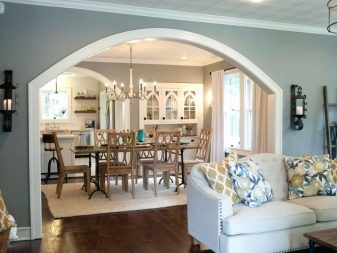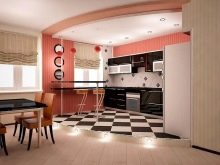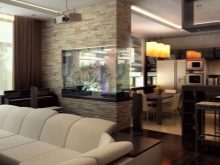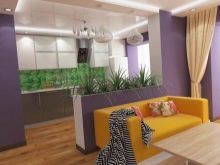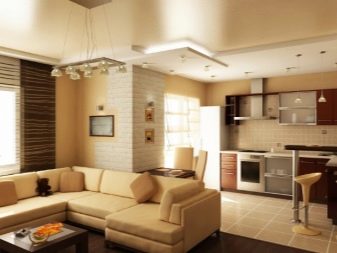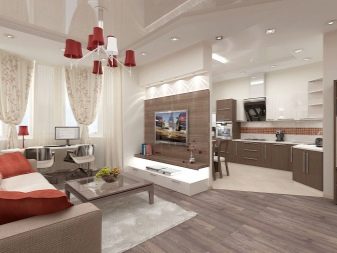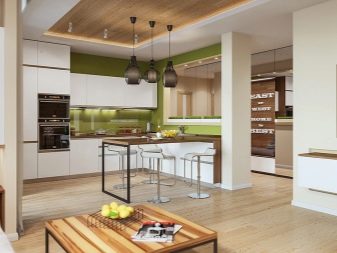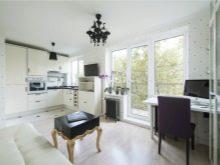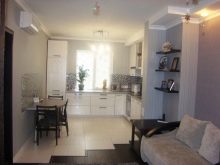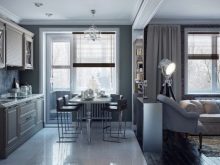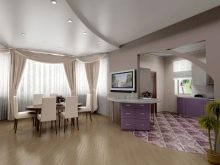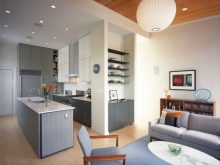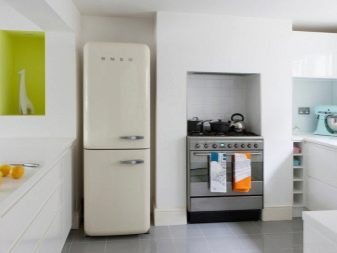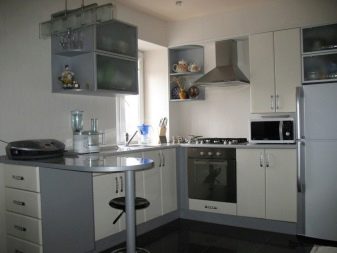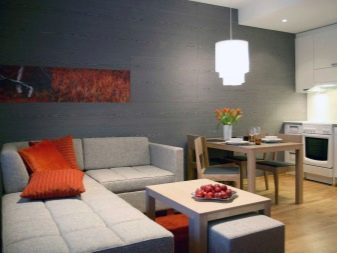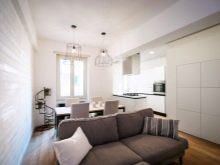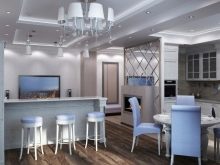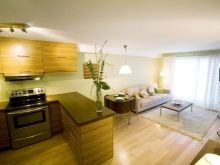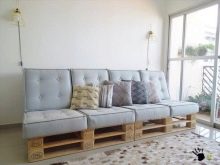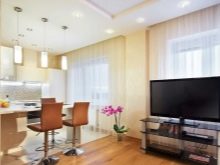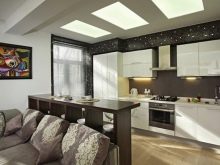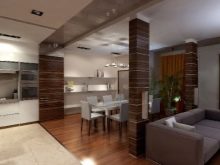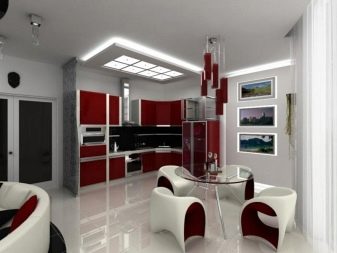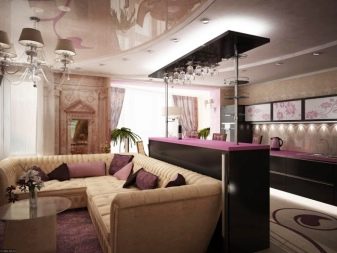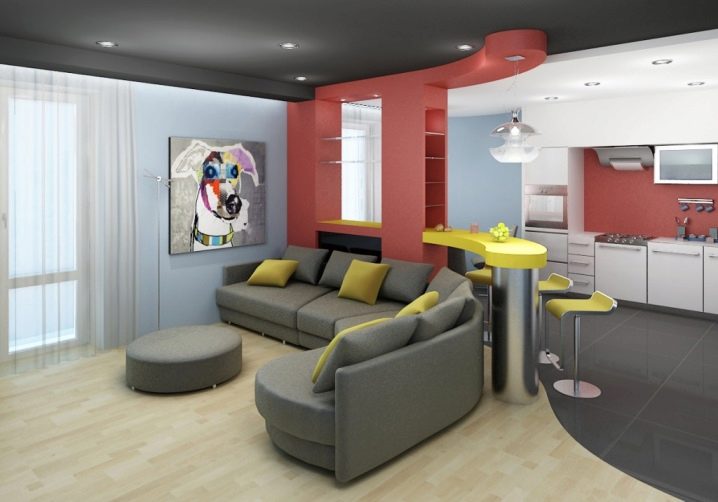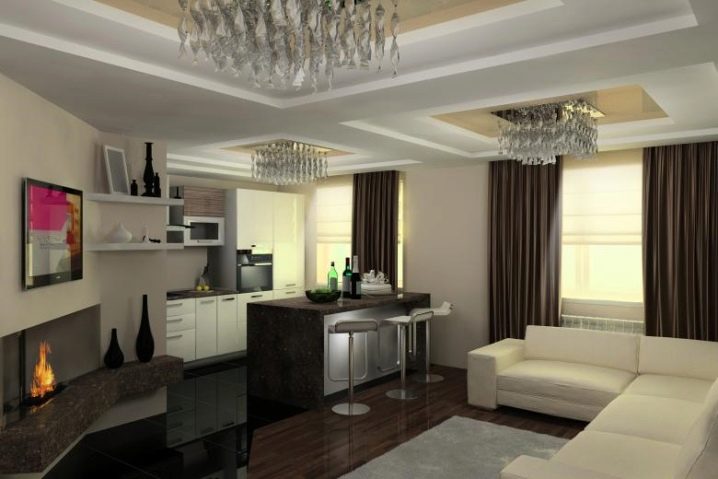Kitchen kitchen design projects: layouts and zoning options
There are many advantages in combining a kitchen and a living room when repairing a household. For those who like to make a magnificent feast, inviting many guests, this situation is good news.
Many dishes and drinks do not have to be carried too far, the free space becomes much larger. Such a transformation improves the layout, it has a number of positive aspects.
The advantages of combining
Small kitchens are present in most flats built in the 60-70s, a large family and guests at the same table can not gather. If the guest room is small in size (which is not so rare), it is also difficult to establish a festive table and invite many guests. The design of a combined living room kitchen is needed in several cases:
- many areas are required for zoning;
- in the most private household or country house there is a spacious kitchen, which in the case of combination with the dining room provides a large amount of space, you can still make a small room;
- after the overhaul, a free area appeared which can be used with great benefit.
All these factors contribute to the popularity of the combined kitchen-living room.
The fashion for such projects appeared in America and in France as early as the 70s of the last century. Gradually, the rationality of this model was realized on all five continents, including in Russia. The free space (if the ceilings are more than three meters) makes the living space, in fact, more comfortable.
When creating a project, you should consider the fact that the premises can perform a variety of functions.There are both positive and negative sides to this. The apartment significantly grows in size, which often can not but rejoice. This is especially a positive fact for people living in "Khrushchev", where the rooms are extremely small.
Increasing the living space in 80% of cases is still associated with improving the quality of housing.
For example, lovers of kitchen gatherings in the spirit of the 60s of the last century may relate negatively to such a phenomenon. Housewives who love to "conjure" near the stove, are also unlikely to be delighted with such redevelopment.
disadvantages
It is important to understand at the very beginning that if the wall between the kitchen and the living room is bearing, then the project will not work. The bearing wall is a taboo; no supervisory authority will give permission for its dismantling. If the landlord decides to go against these rules, he will face costly legal proceedings, fines, and the restoration of the wall as it was originally.
Of the drawbacks of the demolition of the bulkhead, you can remember first of all that all smells during cooking will spread throughout the apartment.
To mitigate such effects is possible by installing a powerful hood. But the work of household appliances can be a hindrance when watching TV.
Style selection
If the homeowner lacks construction skills, then the design and development of the project is best left to professional people.You can find an analogue that appeals, and take it as a starting point.
On fingers or a schematic drawing, it is really difficult to explain to a specialist: what should be the apartment after repair. Two illustrations (or even one) are enough for the future artist to understand what the customer wants.
If you choose a difficult road, and start doing the project yourself, then this idea can be crowned with triumph (which happens rarely). A homeowner can acquire a new profession by making repairs in accordance with his ideas about beauty and style.
In any case, it is important to choose the right color scheme. To do this, you should clearly understand the purpose of each of the zoned areas. The following factors are also important:
- intensity of natural and electric lighting;
- estimated color of the furniture;
- what will be the walls of the wallpaper (and whether they will, in general);
- what material the floor will be made of.
Such basic factors are the cornerstone for creating the right style.
High-tech is always distinguished by straightforward and uncompromising lines. Characteristic of this style:
- high technology priority;
- flexibility and agility;
- unusual ideas.
This design is ideal for young people up to 35 years old, who have an interesting high-paying job, follow the world of fashion and innovative solutions in the technical field.
In the high-tech there is no place for monograms and artsy figures. The presence of even walls (brick, concrete) is acceptable, they may not even be plastered. Doors most often sliding. All fixtures are “hidden” in the walls and plasterboard. The furniture is faced with metal panels, becoming an organic continuation of the walls and floor.
In the living room and kitchen there is an abundance of equipment, so such a stylistic decision may be ideal. Due to the reflection of light from the metal room "moves apart", it becomes more voluminous.
The classic is back on the catwalk of fashion, and this is good news for the adherents of the classical style. Now he unconsciously affirms the “celebration of life” of the Renaissance and optimistic harmony.
The classic style due to the traditional excesses in the design can effectively create the illusion of greater light and volume in the room. It requires, above all, original ideas and solutions.
Often, furniture and accessories are made on special projects. This style is appropriate in large rooms, the design implies a general stylistic burden. There are many subtypes of classics:
- Ancient Greece;
- Ancient Rome;
- Baroque;
- Renaissance and classicism;
- Artsy Empire.
Minimalism as a style implies the presence of free space. What designers call "air presence." At the same time, there should be a minimum amount of furniture in the room, in this respect there should not be any excesses.
Layout options
In any case, if you demolish even the partition, then you will need to agree on the design project in the supervisory authorities, the written permission of the BTI. It does not matter how many square meters will be indoors: 24 square meters. m, 40 or 18.
Before seriously thinking about drawing up a plan, it is recommended to meet with a person who has been professionally engaged in repairing apartments for years. Good advice will always be needed during the repair process.
Square or rectangular area of the kitchen and living room can be designed in the same style, but there are good options and various style solutions. Consider the algorithm of action.
First of all, be sure to make a plan diagram on drawing paper. Mentally "put" the furniture where it will be after repair, denoting this fact in the drawing.
As a zoning tool is usually used:
- bar counters;
- various openings, such as arches;
- a small greenhouse from living plants;
- aquariums of different sizes;
- make the floor with a podium.
And also has a large variety of color palette. “Dyeing” the kitchen in radically maroon tones may not be worth it, but using various soft colors for the kitchen and living room is quite a reasonable decision. Kolerov's excessive contrasts are also pretty tiring on the eyes; here it is more rational to choose a middle ground.
If the construction of a private household is still at the project stage, then it is “easy to do on paper”, and then it is easy to combine the kitchen and living room.
Modern 3D programs allow you to depict the future of a room on a computer and even choose the color of wallpaper and tiles on the floor. The situation is much more complicated when the house has stood for decades, in this case it makes sense to turn to people who have experience with similar projects.
In advance, you should find out how complete the communications are to the kitchen (in general, whether they are all available). Be sure to plan places for new outlets, wiring is likely to have to be changed. If desired, the kitchen can be "squeezed" to the minimum size, then one large living room will appear, which sometimes looks very impressive.
Originality of the room gives primarily high-quality lighting.
There are various developments of layouts that allow you to effectively transform the space, “narrowing” it or “expanding” it. Here are just some of them:
- furniture is placed along the walls;
- all kitchen appliances are interchangeable, they can have several uses;
- the whole kitchen looks the same tone as the living room;
- all the knobs and covers of kitchen utensils are styled to match the tone of the furniture.
It rarely happens that new owners who have bought an apartment are satisfied with the old layout. Often, "helps out" drywall, you can use it to hide communications, make two-level ceilings, and the like. All this is only part of the solution to the problem, although it is very important.
Not the last role played by a reasonable layout of household appliances and kitchen furniture. For example, in a niche in the kitchen you can put kitchenware and household appliances. All this can be “disguised” by doors styled as living room furniture. Thus, there will be a monotonous "landscape" in which the kitchen will become an organic continuation of the living room.
In any case, you should keep the old postulate that three objects should be at arm's length:
- fridge;
- washing;
- plate.
You can place them in the corner near the window, in which case they will look compact. The breakfast and lunch table is most often located in the living room. In general, it can be noted that the combination of kitchen and living room is an art. You can spend a lot of money, while not achieving the desired result. You can also implement a modest budget option, and it will look great.
To make repairs original and cheap, you should adhere to the following postulates:
- bulky furniture should be located in the corner;
- when making better to use light colors;
- furniture should not be "heavy" - a la grandmother's dresser;
- traditional furniture walls conceal space;
- light tinting is achieved by various “patches” (vases, mats, furniture covers, white tile);
- very well "pushing" the space of large mirrors, they can be installed in the door of furniture, hang on the ceiling, attach to the wall.
In recent years, furniture has been actively made from pallets. If the wood is well processed (primed and painted), then from the pallets you can make shelves, tables and much more.
Before starting to work, it is recommended to draw three-dimensional sketches of the kitchen-living room on a computer. It is not expensive, but then it will be 80% clear: is it worth it, in general, to undertake such work, you can spend a lot of money and time without getting the desired result. Sometimes it is enough to confine to a modest redecoration, and do not touch anything.
Zoning
Zoning is most often done by differentiating the materials from which the floors are made. In recent years, very often the kitchen is “paved” with ceramic-granite tiles, in the living room you can put laminate flooring or oak parquet on the floor. The zoning factor is important, it visually erects an invisible “wall”, unconsciously there remains an understanding of where the kitchen is and where the living space is.Often, the zoning factor is even strengthened intentionally, revealing the kitchen walls with the same granite, duplicating it even on the ceiling. This option does not always look perfect, but in most cases it can be quite working.
Wall decoration is a continuation of the zoning idea. The combination of materials can be very different, here everything depends on the homeowner's aesthetic preferences.
The importance of coverage cannot be discounted. Modern LED lamps in two-level gypsum ceilings can work wonders. Lighting can change radically with the installation of several rows of LED lamps. And also with the help of light, you can build an invisible "partition", which will emphasize the boundary between the kitchen and living room.
The last twenty years, they often put a bar on the kitchen; it seems to be the center of gravity, which at the same time emphasizes the functionality of this space.
There are other options that are not as common, however they exist. Do folding partitions or hang thick impermeable curtains.
Successful examples of the interior
American style combining kitchen and living room.Such a design can be found most often on the East Coast of the USA. Democratic style is that such sofas can be located in a roadside cafe, and in the house of a multimillionaire. An interesting solution is when the living space almost completely “absorbs” the kitchen due to the solid floor and walls. That is how many private households on the East Coast are arranged.
Zoning with the use of a bar counter and the floors of different color schemes unobtrusively makes it clear where the “living” zone is and where dinners are being prepared. Two-level gypsum ceilings are also involved in zoning. Expanding and narrowing the space of the room can be switched LED lamps.
An example of how the kitchen "shrinks" to the very minimum. It is almost invisible. Useful living space literally "reigns" in the room.
Overview of the kitchen-living room in the next video.
